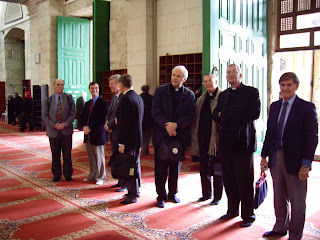This morning the various Australian delegates were free to attend services of their respective Christian traditions in Jerusalem. I joined three of our members for worship at the
Cathedral Church of St George the Martyr, 20 Nablus Rd, West Jerusalem, near the Damascus Gate. The worship was broadly evangelical, in Arabic and English, and included communion. About 25 local Christians shared the service with us, and enjoyed morning tea of Arabic coffee and Arabic sweets.
At morning tea, I spoke to two men about the conflict and how it has impacted and continues to impact their lives. One, a senior public servant who preferred to remain anonymous, spoke about the 1967 war, claiming it was not a war but "an efficient means of transferring land from Jordan to Israel." Another, a senior administrator in a hospital in the West Bank, described his experience as a child whose family was displaced in the 1948 war; more recently, because of the Separation Barrier, his family was forced to abandon their home and prevented from attending the church with which they had been associated for many years. He drove us past the beautiful stone church and back to our hotel. Such stories could be repeated a thousand-fold, and these people are not terrorists, despite what they have suffered and lost.
Incidentally, few people realise that
St George was not British but Palestinian (yes, that's right, the guy who fought the Dragon). He is reputed to have been born in Bithynia to a Palestinian mother, and died as a martyr in Palestine, executed by Roman Emperor Diocletian.

 Pictures:
Pictures:1. (L-R): Rev Merrill Kitchen, Dr Kevin Bray, Bishop Suheil Dawani, Archbishop Phillip Aspinall, at the entrance to the cloister of St George's Cathedral.
2. Interior of the Cathedral.
Trivia: Ship of Fools
Mystery Worshipper has logged a visit to St George's Cathedral (and, like me, liked the experience).
 In the evening of Sunday 9 Dec 2007, our Australian delegation met with Episcopal Bishop Suheil Dawani in a meeting room at St George's Cathedral in West Jerusalem.
In the evening of Sunday 9 Dec 2007, our Australian delegation met with Episcopal Bishop Suheil Dawani in a meeting room at St George's Cathedral in West Jerusalem.






 Pictures:
Pictures:





 Pictures:
Pictures:

 Pictures:
Pictures:








 Pictures:
Pictures:









